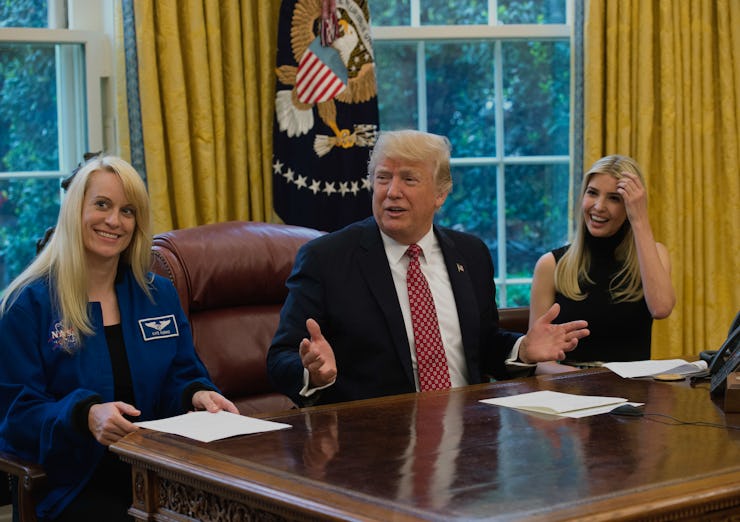No One Knows If Trump is Serious About Going to Mars by 2024

President Donald Trump took some time Monday morning to congratulate NASA astronaut Peggy Whitson for setting a new record for the most time cumulatively spent in space. Whitson and her crewmate Jack Fischer, currently aboard the International Space Station, took a few minutes to speak with Trump and chat about the different kinds of audacious things NASA and the international community are working on — including positioning the agency to send astronauts to Mars in the 2030s.
It was clear Monday morning Trump had little clue that was the game plan.
Trump pointedly asked Whitson and Fischer to explain what was going on with Mars. “Tell me,” he said. “Mars, what do you see a timing for actually sending humans to Mars? Is there a schedule and when would you see that happening?”
Whitson replied: “Well, I think as your bill directed, it’ll be approximately in the 2030s.” She was referring to the new NASA Authorization Act of 2017 which Trump signed last month. The act basically doubles down on current efforts to launch a crew to Mars by 2033 — first as an orbital mission, and a year later as a landing on the surface.
Trump seemed oblivious to what his bill was all about.
“As I mentioned,” Whitson continued, “we actually are building hardware to test the new heavy launch vehicle, and this vehicle will take us further than we’ve ever been away from this planet.” This was in reference to the new Space Launch System, a rocket designed to facilitate deep space exploration.
“We want to try and do it during my first term”
Trump followed up the exchange by telling Whitson, “Well, we want to try and do it during my first term or, at worst, during my second term, so we’ll have to speed that up a little bit, okay?”
It’s unclear if the president was joking. He could have been playing the role of air-time, ratings hungry talk show host, but if he was looking for actual answers — also a distinct possibility — Neither Whitson nor Fischer nor any other astronaut is responsible for leading the Mars program.
It’s also unlikely NASA can actually pull off a crewed launch to Mars by the end of 2024 — there is simply too much to build and test before the agency can green-light a mission to Mars while confidently ensuring the safety of the astronauts onboard.
Finally, a mission to Mars won’t simply be a quick hop to the red planet and a hop back into the spacecraft to come back to Earth. A crew that goes to Mars will likely be staying for quite a bit of time in habitats built by robots, using tools and instruments and infrastructure that’s been carefully constructed and designed to allow the astronauts to conduct a wide array of experiments and studies. Getting all of that set up will require several years — the bulk of the latter half of the next decade, well beyond the end of the Trump presidency (should it go for two terms).
Even if Trump was joking, making those kinds of comments on air seems irresponsible. The agency is currently in a fraught position — its hands are being tied when it comes to the critical work of studying earth science, it may be forced to direct more resources towards lunar missions, and there is a strong push within the administration to make more room for private companies. None of these things really fit with the Mars program. Telling the agency to get a mission to Mars done before 2024 helps no one.
This is nothing new, however. Trump has adorned his presidency in a motif of inconsistency, unpredictability, and a reckless proclivity to make unsubstantiated claims and bombastic remarks that run counter to enforcing clear policy objectives.
If Trump really does want NASA to get to Mars before 2020 or 2024, it would be hard to be surprised.